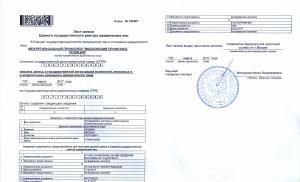Internal and external pricing factors. Factors influencing the pricing process
The pricing factors are driving forces, significant circumstances, the main reasons that have a decisive impact on the formation of prices. Before developing a pricing strategy, the company must analyze all the factors influencing the decision on prices.
Evans and V. Berman identified five main factors that greatest influence on the pricing process: consumers, government, channel participants, competitors, production costs. All these factors can be divided into two main categories - internal and external.
TO internal factors that determine the level of prices of commodity producers include: the level of production costs; features of the production process (small-scale, individual or mass); the specificity of the products produced (the degree of its processing, uniqueness, quality); availability of resources necessary for production (labor, material, financial); organizational level, degree of use of progressive production methods; market strategy and tactics of the manufacturer, etc.
External factors influencing the pricing process for a product of a particular manufacturer include: consumer preferences for this product (favorable or unfavorable); income level of buyers; consumer expectations regarding future price changes and the producer's own INCOME; prices for related goods (interchangeable, complementary); prices and non-price offers of competitors, etc. factors of an external order are practically not subject to the control of commodity producers, but they are necessarily taken into account when pricing products.
The pricing process consists of a number of successive stages: 1.
Identification of factors external environment affecting the price level. 2.
Setting pricing goals. 3.
Choice of pricing method. 4.
Formation of the pricing strategy of the enterprise. 5.
Development of pricing tactics. 6.
Setting the initial price for the product. 7.
Market price adjustment. eight.
Price insurance against adverse external influences.
This approach represents the pricing process at the enterprise in the very general view. He is not immutable. It should be taken into account that any of the above stages can have the strongest and most unexpected impact on previously set prices and correct them.
Thus, it is difficult to overestimate the importance and influence on the establishment of Prices of factors of the external environment, which includes such factors as market conditions, competition, demand. These factors have a direct impact on the change in the pricing strategy, which is a component of the survival of the enterprise in the long term.
The pricing method chosen may also be subject to significant adjustment as it may be influenced by the most different factors: pricing traditions adopted by the Zhdannaya industry; competitor behavior; change in government policy regarding cost accounting and taxation policies, etc.
The essential point is the Chena market adjustment, carried out at the moment when the product is already in the sales gap. The manufacturer is not able to change the costs incurred, the volume of products in stock. Price becomes for him the only means of adaptation to changing demand. At this stage, the establishment of times is of particular importance. personal kind of discounts to the price in order to attract additional consumers.
Thus, in relation to the enterprise, there are a number of factors that significantly affect the pricing process, forming certain boundaries within which the enterprise can operate (Fig. 6.5). First of all, they affect the degree of freedom of action of the enterprise in the field of pricing for its products.
Rice. 6.5. Environmental factors affecting the pricing process
at the enterprise
Let's bring brief description each of these factors. one.
Consumers. Buyers significantly influence the activities of enterprises in the field of pricing. In order to properly respond and take into account their behavior, the enterprise needs to have certain knowledge about general patterns and their behavior in the market. This includes, first of all, psychological aspects customer behavior: needs, needs, requests, motivation when choosing a product or service, ways of consumption, attitude to goods and services, attitude to the new, consumer sensitivity to prices and quality of goods and services.
In addition to psychological, there are also economic aspects of consumer behavior. This includes concepts such as purchasing power, budget constraints and their relationship to consumer preferences. Due to the fact that the budget of the buyer is limited, and prices are subject to constant changes, the buyer is constantly faced with a choice: how to use his budget in the most rational way, which product to buy and which not. According to the theory marginal utility and consumer choice, the buyer will prefer the product that best matches his personal idea of the usefulness of the upcoming purchase, combined with his financial capabilities. 2.
Market environment. The market environment is a very complex multifaceted concept. It is formed under the influence a large number economic, political and cultural factors. There are usually four main market models: pure competition, monopolistic competition, oligopoly, pure monopoly. In terms of pricing, the main hallmark of these markets is the degree of influence of the enterprise on the establishment market price.
The maximum influence is in the condition of monopoly, the minimum - in the conditions of the market of perfect competition. The price in the market can be controlled by an individual firm, a group of firms, the state and the market. 3.
Members of distribution channels. Product distribution is a process that ensures the delivery of goods to the final consumer. It is known that there are three main types of distribution channels: 1)
direct - goods and services are delivered to the final consumer without the participation of intermediaries; 2)
indirect - goods and services are delivered to the final consumer with the help of one or more intermediaries; 3)
mixed - combine the features of the first two types of channels.
From the point of view of pricing, the influence of the participants in the distribution channels on the increase in prices is of interest. How more intermediaries is located between the manufacturer of the goods and its final consumer, the more retail price will be higher than the selling price, the initial price of the enterprise - the manufacturer of this product. Ultimately, this leads to a limitation of demand for goods and services, which, in turn, stimulates price reduction and thus helps to optimize the distribution channels. At the same time, in the case of a multiplier effect, the situation may be just the opposite - in the process of rising prices, the phenomenon of unlimited demand will be observed, since ® Movement will come an inflationary spiral of prices - wages. 4.
State. There are three degrees of state influence on pricing: price fixing; regulation of prices by setting their limit levels; regulation of the free pricing system.
The state uses three main ways to fix prices: 1)
use of list prices. Price lists for goods H Services is an official collection of prices and tariffs, approved and published by ministries, departments, state pricing bodies. The number of prices set using price lists can be very different: close to 100% in conditions of strict total state control over the price level and insignificant, close to zero - in cases of a predominantly market-based pricing method. Usually, the prices of monopoly enterprises are subject to regulation with the help of price lists: electricity, gas, oil, public Utilities, transport. Prices for these products cause a multiplier effect in the economy, so fixing them at a certain level contributes to the stabilization of the entire economic situation and determines the degree of price stability in all other areas. The most difficult thing here is to determine the level at which the price in the price list should be fixed. Fixing prices at a level above the market price leads to a state of excess supply in the market, fixing prices at a level below the market price - to a shortage; 2)
fixing monopoly prices. The state fixes the prices of enterprises that occupy a dominant position in the market, which allows it to decisively influence competition, market access and price levels, which ultimately limits the freedom of action of other market participants. Decide whether the this enterprise dominant or not, antitrust law helps. By Russian legislation the enterprise occupies a dominant (monopoly) position if its market share is from 35 to 65%; 3)
freezing prices. This approach is used in case of disproportions in prices or crisis situations in the economy and is carried out solely for the purpose of stabilizing the situation. It is considered expedient to apply price freezes only in the short term.
Regulation of prices by setting their limit levels (setting an upper or lower price limit) includes: the introduction of fixed coefficients in relation to list prices; setting marginal allowances; regulation of the main parameters that affect the formation of prices (the procedure for the formation of costs, the maximum amount of profit, the size and structure of taxes); establishing maximum size one-time price increase; determination and regulation of prices for products and services of state enterprises.
Regulation of the free pricing system through legislative regulation of the pricing activities of market participants, restriction of unfair competition consists in the introduction of a number of prohibitions: 1)
ban on dumping - a ban on the sale of goods below cost - I
its production in order to eliminate competitors. This practice is especially relevant if there is a leader in the market who seeks to force competitors out of the market or prevent them from entering this market. In addition, such a ban is widely used in practice. international trade to prevent aggressive importers of products with low production costs from entering the market; 2)
a ban on vertical price fixing - a ban on manufacturers to dictate their prices to intermediaries, wholesale and retail trade; 4)
ban on horizontal price fixing - a ban on the agreement of several manufacturers to maintain product prices at a certain level if the aggregate market share of these enterprises will provide them with a dominant position in the market. This limitation is especially relevant in an oligopolistic market. However, it is easy to ignore it, for example, if oligopolistic enterprises agree among themselves not on a single price, but on a single method for calculating costs and determining the price of final products.
The formation of prices is significantly influenced by the so-called pricing factors. They represent various objective conditions that predetermine the level, structure, proportions and dynamics of prices for goods and services.
The main factors affecting the price level are:
1) supply and demand;
2) competition;
3) the state of the financial and credit system;
4) state regulation prices;
5) the behavior of participants in distribution channels and consumers;
6) costs of production and sale of products.
Demand plays a key role in determining the price of a product. The volume of demand is determined by the amount of goods that the buyer is willing to purchase under given conditions during a certain period of time. Demand depends on many factors (for example, the price of substitute goods, the number of buyers, etc.), the main of which is the price of the goods.
The relationship between the price of a good (P) and the demand for it (Q) is described in Chart 1.
Graph 1 "Demand Curve".
The demand curve sets back proportional dependence between the price of a commodity and its quantity. Indeed, the higher the price, the fewer goods at that price can be bought. On the other hand, an increase in the number of goods on sale causes a decrease in the price of it.
Not less than important role supply plays a role in setting the market price. Supply is the quantity of a product that sellers are able and willing to offer to a buyer at a specific time and certain place. The relationship between the price of a good (P) and its supply (Q) can be represented in Chart 2.

Graph 2 "Supply Curve"
The supply curve establishes a directly proportional relationship between the price of a good and its quantity, i.e. price increases interest manufacturers in increasing sales volumes.
The value of the supply of goods (as the value of demand), in addition to price, is influenced by other factors: for example, the prices of competing goods, the number of sellers, the level of production technology, public policy in the field of taxation, etc.
Under the influence of these factors, the supply curve can shift in one direction or another. So, for example, with an increase in the number of sellers selling goods at the same price P1, the supply increases from Q1 to Q2.
The price at which supply and demand are equal is called the equilibrium price. This is exactly the price at which the product will be sold. Consider Chart 3.

Consider the mechanism of market pricing for free competitive market, where the supply and demand of a good depends mainly on its price.
If buyers want to buy a product at a price that is below the equilibrium price, then demand will be greater than supply. There is a shortage of goods. As a result, the price will increase until supply equals demand.
If the sellers sell the goods at a price that is higher than the equilibrium price, then the supply will be higher than the demand. There is an excess of goods. As a result, the price will decrease until supply and demand balance.
Thus, in a free competitive market, in conditions where the demand and supply of goods mainly depend on price, an equilibrium market price is established, which corresponds to the point of intersection of the supply and demand curves.
In the real market, in addition to price, there are a number of other non-price factors that affect supply and demand, which leads to a shift in the corresponding curves. At the same time, the equilibrium price also changes.
1. The case of fixed supply (unchanged supply, independent of non-price factors) and demand changing under the influence of the same factors.

As can be seen from Chart 4, as the demand for the product increases, which corresponds to the curve moving from position C1 to position C2 and further to position C3, the equilibrium point shifts from position 1 to position 2 and then to position 3. At the same time, the equilibrium price Рр, respectively increases from the value of Pp1 to the value of Pp2 and further to the value of Pp3. In the case of a decrease in demand for a product (with an unchanged offer), the opposite picture takes place, i.e. the equilibrium price falls.
2. The case of fixed demand (that is, independent of non-price factors) and supply changing under the influence of the same factors.
As can be seen from Graph 5, as the supply of goods increases, which corresponds to the shift of the supply curve from state P1 to state P2 and then P3, the equilibrium point moves from position 1 to position 2 and then to position 3. In this case, the equilibrium price decreases from the level PP1 to the level of PP2 and PP3. In the case of a decrease in supply (with a constant demand), the reverse picture is observed (i.e., the equilibrium price increases).
Unlike a free competitive market, real markets are more or less monopolized.
On the monopoly market the demand for a product follows the demand curve, and the supply curve is determined by the behavior of the market monopolist. He is guided by the desire for a given demand to extract as much profit as possible by selling the goods, and on this basis he builds his offer of the goods. Thus, in the monopoly market, along with demand, the price is formed under the influence of the principle of maximizing the profit of the producer (seller) of the goods.
We also consider competition and its impact on the price level.
Competition is both price and non-price. At price competition Selling firms, following the demand curve, lower prices below market prices. At the same time, competitors who do not have the ability to reduce the price cannot stay on the market: they leave it or go bankrupt.
When non-price competition sellers try to attract buyers in the first place unique properties product, for example, its technical reliability or high quality.
Depending on the forms of competition, it is also customary to distinguish the following types of markets:
1) The market of pure (“free”) competition;
2) The market is monopolistic competition;
3) Market of oligopolistic competition;
4) The market of pure ("absolute" monopoly).
The market of pure (free) competition consists of many sellers and buyers of interchangeable goods that do not have much influence on the level of current prices. Since the number of sellers and buyers in such a market is quite large, for example, several thousand, none of them is able to influence the processes, and, above all, current prices. In such an ideal market, the seller and the manufacturer behind him can only improve their position by reducing the cost of production or improving its quality. This achieves a simultaneous gain for the producer and the consumer, who buys goods at lower prices.
The market of monopolistic competition also consists of many sellers and buyers (although there are fewer of them than in the previous free market). In this market, sellers are able to offer buyers different variants goods at a wide range of prices. In such a market, the importance of non-price factors is great.
Most typical of modern market economy is the so-called oligopolistic market. This market is made up of a small number of sellers who are highly sensitive to the pricing policies and marketing strategies of competitors. This is explained by the fact that in the oligopolistic market each of its participants occupies a rather significant position, since it accounts for a significant part of sales.
The state of the financial and credit system also has a significant impact on the level and dynamics of prices. The relationship between prices and finance is clearly seen primarily in the distribution function of price. In accordance with this function, those principles and forms of distribution are realized through prices. public product, which are accepted in this economic system. So, for example, on the one hand, prices provide producers with reimbursement of current costs and a part of the profit remaining after paying all types of taxes. In turn, taxes and deductions, being sources of replenishment of the state budget, the formation of extra-budgetary funds, ensure close interaction between pricing and the entire financial system.
The pricing process is also influenced by the behavior of all participants in the distribution channels - from the manufacturer to the wholesaler and retail. All of them seek to increase the volume of sales of goods, to establish greater control over prices in order to maximize profits. For example, manufacturers open their own stores, where they trade at lower prices.
Prices are also affected by the behavior of consumers (buyers). In this regard, all buyers, depending on their perception of prices for goods and orientation in purchases, can be divided into four groups:
1) Thrifty buyers who, when choosing a purchase, are more interested in prices, quality and assortment of goods;
2) Personalized buyers, i.e. as if creating for themselves a certain image of the product they want to buy;
3) Ethical buyers who, according to a long-established tradition, purchase goods in certain stores, regardless of prices and assortment of goods;
4) Apathetic buyers who, when choosing a purchase, focus not on price, but on the convenience and comfort received from the purchase of goods.
The last pricing factor is the cost, or costs of production and sale of products. These costs form the basis of the price of goods and largely determine its level. For example, in industry, the share of prime cost in the selling price of an enterprise (without VAT and excises) is over 80%, and in railway transport - over 85%.
The composition of costs includes costs, both dependent and independent of the activities of the enterprise, i.e. external to him. For example, the cost of raw materials, materials, fuel, energy, transport tariffs are factors external to the enterprise. An increase in these costs causes an increase in the price of the product. Here, the enterprise can influence the price reduction only indirectly, for example, by choosing cheap suppliers. Another group of costs - such as wages, overhead costs depend on the activities of the enterprise and can be regulated.
Depending on the strength of its position in the market, the company can maneuver the prices of goods. If the position of the company is not stable enough and the increase in product prices is undesirable, then, for example, the rise in the cost of raw materials can be compensated to a certain extent by reducing the consumption rates of raw materials or by using secondary resources.
The price, as already noted, is the amount of money that is paid for the goods. The value of money is determined by its purchasing power, i.e. what they can buy. In a market economy, the change in the purchasing power of money within certain limits occurs constantly. A significant increase in prices occurs as a result of a sharp increase in inflation and other crisis phenomena that cause a significant deterioration in macroeconomic indicators and their derivatives, which include gross and national product, external and internal debt of the country, deficit and real size budget, issue size, lending rates, quotes on the stock and currency markets. Other factors also influence price growth: the level of perfection of the tax system and development legislative framework, Existence shadow business and corruption, crime, unemployment, level and life expectancy, ongoing political events, the state of the world economy, etc.
Price setting is a difficult and complex process that requires taking into account a large number of factors. One of the factors influencing price formation is the economic value of the product. In the field of pricing, the economic value of a good for the buyer or the value that appears in the exchange is understood as the assessment of the desired good, which in monetary terms exceeds its price. From this point of view, value can be realistically measured on the basis of the ratio of utility and price of goods that are alternatives available to buyers. Thus, the total economic value of a product is understood as the price of the best alternative product available to the consumer (the price of indifference) plus the value for him of those properties of the product that distinguish him from this best alternative (the value of differences).
The formation of the overall economic value of the product for the consumer can be described using the following formula:
- total value = cost of indifference + positive difference value - negative difference value.
In other words, when determining the value of a product for himself, the buyer takes as a starting point the price of the best available varieties of goods from other firms that satisfy the same need. The procedure for calculating the economic value of a product can be quite strictly formalized and become the basis for reliable quantitative estimates. In practice, this procedure consists of four main stages: determining the price of indifference, establishing differences, assessing the significance of differences from the consumer's point of view, summing the price of indifference with the estimates of differences.
Stage 1- determination of the price (or costs) of the good (goods or technology) that the buyer is inclined to consider as the best of the alternatives actually available to him. At this stage, you should functionally measure and determine the price that the buyer will pay if he purchases a functionally commensurate amount of goods offered by competitors.
Stage 2- determination of all parameters that distinguish the product both for the better and for the worse from the alternative. The most frequently analyzed parameters are:
- functioning;
- reliability;
- the number (more or less) of useful properties;
- the content of useful (harmful) substances;
- maintenance costs;
- commissioning costs;
- Maintenance.
Stage 3- assessment of the significance of differences in the parameters of the product and its alternatives from the standpoint of the buyer. At this stage, the differences in the product must be evaluated in monetary terms. Such scores can be obtained in different ways:
- as a result of a survey of experts and sellers;
- by conducting trial sales and customer surveys using special techniques;
- based on calculations economic efficiency(when we are talking about the parameters of the product that can directly reduce the cost of the buyer).
At the same time, it must be remembered that the scale of quantitative changes in the level of one or another consumer parameter of a product in comparison with the parameters of alternative products does not necessarily coincide with the scale of the change in the benefits from its use by the buyer and, accordingly, with the change in the amount of money that he agrees to pay for receiving this product.
Stage 4- summation of the price of indifference and estimates of the positive and negative value of the differences between the product and its alternatives. In this case, it is usually recommended to set the price below the upper limit of economic value in order to increase consumer interest in the product.
In addition, pricing is influenced by numerous external and internal environment, therefore, all other technical and economic parameters are analyzed and predicted mainly to determine the price of goods and services produced. In real conditions, prices are formed under the influence of two groups of factors - internal and external. In other words, in the process of determining the price at the enterprise, it is necessary to take into account information as about the market ( external factors) and costs (internal factors).
For effective organization businesses need to have a clear understanding of what price is, pricing factors, what are the principles for pricing goods and services. Let's talk about how and what prices are made up of, what functions they perform and how to correctly determine the adequate cost of products.
The concept of price
The basic element of the economic system is the price. This concept intertwines various problems and aspects that reflect the state of the economy and society. In its most general form, price can be defined as the quantity monetary units for which the seller is willing to transfer the goods to the buyer.
In a market economy, the same goods can cost differently, and the price is an important regulator of the relationship between market entities, an instrument of competition. Its value is influenced by many pricing factors, and it consists of several components. The price is volatile and subject to permanent changes. There are several types of prices: retail, wholesale, purchasing, contractual and others, but all of them are subject to a single law of formation and existence in the market.

Price functions
A market economy differs from a regulated one in that prices have the opportunity to freely realize all their functions. The leading tasks that are solved with the help of prices can be called stimulation, information, orientation, redistribution, balancing supply and demand.
The seller, by announcing the price, informs the buyer that he is ready to sell it for a certain amount money, thereby orienting the potential consumer and other traders in the market situation and informing them of their intentions. The most important function of establishing a fixed cost of goods is to regulate the balance between supply and demand.
It is with the help of prices that producers increase or decrease the quantity of output. A decrease in demand usually leads to an increase in prices and vice versa. At the same time, price-forming factors are a barrier to discounting, since only in exceptional cases can manufacturers lower prices below the cost level.

Pricing Process
Price setting is a complex process that takes place under the influence of various phenomena and events. It is usually carried out in a certain order. First, the pricing objectives are determined, they are closely related to the strategic objectives of the manufacturer. So, if a company sees itself as an industry leader and wants to occupy a certain market segment, it seeks to set competitive prices for its product.
Further, the main price-forming factors of the external environment are evaluated, the features and quantitative indicators of demand, and the market capacity are studied. It is impossible to form an adequate price for a service or product without assessing the cost of similar units from competitors, so the analysis of competitors' products and their cost is the next stage of pricing. After all the "incoming" data are collected, it is necessary to select pricing methods.
Typically, a company forms its own pricing policy, which it adheres to for a long period. Final stage this process- final price fixing. However, this is not the final stage, each company periodically analyzes the established prices and their compliance with the tasks at hand, and based on the results of the study, they can reduce or increase the cost of their goods.

Pricing principles
The establishment of the cost of a product or service is not only carried out according to a certain algorithm, but is also carried out on the basis of basic principles. These include:
- The scientific principle is not taken “from the ceiling”, their establishment is preceded by a thorough analysis of the external and internal environment of the company. Also, the cost is determined in accordance with objective economic laws, in addition, it must be based on various pricing factors.
- The principle of target orientation. Price is always a tool for solving economic and social problems, therefore, its formation should take into account the tasks set.
- The pricing process does not end with the establishment of the cost of goods in a specific time period. The manufacturer monitors market trends and changes the price in accordance with them.
- The principle of unity and control. State bodies constantly monitor the pricing process, especially for socially significant goods and services. Even in a free, market economy, the state is assigned the function of regulating the cost of goods, to the greatest extent this applies to monopolistic industries: energy, transport, housing and communal services.

Types of factors affecting the price
Everything that affects the formation of the value of goods can be divided into external and internal environment. The first ones are various phenomena and events that the product manufacturer cannot influence. For example, inflation, seasonality, politics, and the like. The second includes everything that depends on the actions of the company: costs, management, technology. Also, pricing factors include factors that are usually classified by subject: manufacturer, consumers, state, competitors, distribution channels. Costs are separated into a separate group. They directly affect the size of the cost of production.
There is also a classification within which three groups of factors are distinguished:
- not opportunistic or basic, i.e. associated with a stable state of the economy;
- opportunistic, which reflect the variability of the environment, these include fashion factors, politics, unstable market trends, consumer tastes and preferences;
- regulatory, related to the activities of the state as an economic and social regulator.

Basic system of pricing factors
The main phenomena that affect the cost of goods are indicators that are observed in all markets. These include:
- Consumers. The price is directly dependent on demand, which, in turn, is determined by consumer behavior. This group of factors includes indicators such as price elasticity, buyers' reactions to them, market saturation. The behavior of consumers is influenced by the marketing activity of the manufacturer, which also entails a change in the cost of goods. The demand, and accordingly the price, is influenced by the tastes and preferences of buyers, their income, even the number of potential consumers matters.
- Costs. When setting the price of a product, the manufacturer determines its minimum size, which is due to the costs that were incurred in the production of the product. Costs are fixed and variable. The first are taxes wages, production service. The second group consists of the purchase of raw materials and technologies, cost management, and marketing.
- Government activities. In different markets, the state can influence prices in many ways. Some of them are characterized by fixed, strictly regulated prices, while for others the state only controls the observance of the principles of social justice.
- Merchandising channels. When analyzing price-forming factors, it should be noted the special significance of the activities of the participants in the distribution channels. At each stage of the promotion of products from the manufacturer to the buyer, the price may change. The manufacturer usually seeks to retain control over prices, for which he has various tools. However, the retail and wholesale prices are always different, which allows the product to move in space and find its final buyer.
- Competitors. Any company seeks not only to fully cover its costs, but also to maximize profits, but at the same time it has to focus on competitors. Because too high prices scare off buyers.

Internal factors
Those factors that the manufacturing company can influence are usually called internal. This group includes everything related to cost management. The manufacturer has various opportunities to reduce costs by looking for new partners, optimizing the production process and management.
Also, internal price-forming demand factors are associated with marketing activities. The manufacturer can help increase demand by advertising campaigns, creating excitement, fashion. Internal factors also include product line management. A manufacturer can produce similar products or products from the same raw material, which helps to increase profitability and reduce prices for some products.
External factors
Phenomena that do not depend on the activities of the manufacturer of goods are usually called external. They include everything related to the national and global economy. Thus, the external pricing factors of real estate are the state of the national economy. Only when it is stable, there is a steady demand for housing, which allows prices to rise.
Politics is also an external factor. If the country is at war or protracted conflict with other states, this will necessarily affect all markets, the purchasing power of the consumer and, ultimately, prices. External are the actions of the state in the sphere of price control.
Pricing Strategies
Given various pricing factors, each company chooses its own path to the market, and this is realized in the choice of strategy. Traditionally, there are two groups of strategies: for new and for existing products. In each case, the manufacturer relies on the positioning of its product and on the market segment.
Economists also distinguish two types of strategies for a product already existing on the market: a sliding, falling price and a preferential price. Each way of setting prices is associated with a market and marketing strategy.
Price setting is a difficult and complex process that requires taking into account a large number of factors. All factors influencing pricing can be divided into two groups - external and internal.
Environmental factors influencing the pricing process.
1. Consumers. Buyers significantly influence the activities of enterprises in the field of pricing. In order to properly respond and take into account their behavior, the company needs to have certain knowledge about the general patterns and characteristics of their behavior in the market. This includes, first of all, the psychological aspects of the behavior of buyers: needs, needs, requests, motivation when choosing a product or service, ways of consumption, attitude to goods and services, attitude to the new, consumer sensitivity to prices and quality of goods and services.
In addition to psychological, there are also economic aspects of consumer behavior. This includes concepts such as purchasing power, budget constraints and their relationship to consumer preferences. Due to the fact that the budget of the buyer is limited, and prices are subject to constant changes, the buyer is constantly faced with a choice: how to use his budget in the most rational way, which product to buy and which not. According to the theory of marginal utility and consumer choice, the buyer will prefer the product that best matches his personal idea of the utility of the upcoming purchase, combined with his financial capabilities.
- 2. Market environment. The market environment is a very complex and multifaceted concept. It is formed under the influence of a large number of economic, political and cultural factors. Usually there are four main market models: pure competition, monopolistic competition, oligopoly, pure monopoly. From the point of view of pricing, the main distinguishing feature of these markets is the degree of influence of the enterprise on the establishment of the market price. The maximum influence is in the condition of monopoly, the minimum - in the conditions of the market of perfect competition. The price in the market can be controlled by an individual firm, a group of firms, the state and the market.
- 3. Members of distribution channels. Product distribution is a process that ensures the delivery of goods to the final consumer. It is known that there are three main types of distribution channels:
direct - goods and services are delivered to the final consumer without the participation of intermediaries;
indirect - goods and services are delivered to the final consumer with the help of one or more intermediaries;
mixed - combine the features of the first two types of channels.
From the point of view of pricing, the influence of the participants in the distribution channels on the increase in prices is of interest. How large quantity intermediaries is located between the manufacturer of the goods and its final consumer, the more the retail price will be higher than the selling price, the initial price of the enterprise - the manufacturer of this product. Ultimately, this leads to a limitation of demand for goods and services, which, in turn, stimulates price reduction and thus helps to optimize the distribution channels. At the same time, in the case of a multiplier effect, the situation may be exactly the opposite - in the process of price growth, the phenomenon of unlimited demand will be observed, since an inflationary price-wage spiral will set in motion.
- 4. State. There are three degrees of government influence on pricing
- 4.1 Fixing prices. The state uses the following main methods of fixing prices - the use of price lists. Price lists for goods and services is an official collection of prices and tariffs, approved and published by ministries, departments, state pricing bodies. Usually, the prices of monopoly enterprises are subject to regulation with the help of price lists: electricity, gas, oil, utilities, transport. Prices for these products cause a multiplier effect in the economy, so their fixation at a certain level contributes to the stabilization of the entire economic situation and determines the degree of price stability in all other areas. Fixing prices at a level above the market price leads to a state of excess supply in the market, fixing prices at a level below the market price - to a shortage.
fixing monopoly prices. The state fixes the prices of enterprises that occupy a dominant position in the market, which allows it to decisively influence competition, market access and price levels, which ultimately limits the freedom of action of other market participants. Under Russian law, an enterprise occupies a dominant (monopolistic) position if its market share is between 35% and 65%;
freezing prices. This approach is used in case of disproportions in prices or crisis situations in the economy and is carried out solely for the purpose of stabilizing the situation. It is considered expedient to apply price freezes only in the short term.
4.2 Price regulation through price caps
(setting an upper or lower price limit), introducing fixed coefficients in relation to list prices, setting marginal markups, regulating the main parameters that affect pricing (the procedure for setting costs, maximum profit, size and structure of taxes), setting the maximum size of a one-time increase prices, determination and regulation of prices for products and services of state enterprises.
4.3 Regulation of the system of free pricing through legislative regulation of pricing
activity of market participants, restriction of unfair competition. This method The influence of the state on the pricing process consists in the introduction of a number of prohibitions:
ban on dumping - a ban on the sale of goods below the cost of its production in order to eliminate competitors. It is especially important if there is a leader in the market, seeking to force competitors out of the market or prevent their entry into this market.
a ban on vertical price fixing - a ban on manufacturers to dictate their prices to intermediaries, wholesalers and retailers.
ban on horizontal price fixing - a ban on the agreement of several manufacturers to maintain product prices at a certain level, if the aggregate market share of these enterprises will provide them with a dominant position in the market. This limitation is especially relevant in an oligopolistic market. However, it is easy to ignore it, for example, if an oligopolistic enterprise agrees among themselves not on a single price, but on a single method for calculating costs and determining the price of final products.
Internal factors should also be taken into account when pricing. The most important place among these factors is the cost. It is necessary to compare the amount of costs with the possibility of covering them when setting the price. The survival of the company depends on the extent to which not only current costs are covered, but also the costs associated with capital investments designed for a long period.
Factors of the internal environment influencing the pricing process:
Production cost
Need to cover long-term capital investments
Quality of materials and labor
Labor intensity of production
Using limited resources
In practice, when pricing, enterprises take into account information about both the market (external factors) and costs (internal factors).













